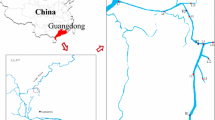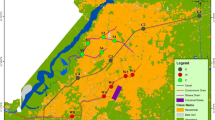Abstract
The occurrence and fate of five endocrine disrupting chemicals (EDCs), including nonylphenol (NP), 4-tert-octylphenol (4-t-OP), 4-tert-butylphenol (4-t-BP), bisphenol A (BPA) and norethindrone (NET) was investigated in four wastewater treatment plants (WWTPs) and receiving river (Suzhou River and Yangtze River) of Shanghai. Selected EDCs in WWTPs influents ranged from 1.02 to 3560 ng L−1, which dominated by NP and BPA. Target compounds detected in effluents were from N.D. to 1136 ng L−1, with NP as most prevalent. The removal rates of target compounds varied from negative of NET to 99 % of BPA. Except of NET, efficiently removal rates (>70 %) were observed in WWTPs. Biological treatment was the major removal stage of selected EDCs in WWTPs. Furthermore, the selected EDCs were detected from N.D. to 424 ng L−1 in receiving river. The correlation analysis suggested EDCs pollution in receiving river might be mainly contributed by WWTPs effluents. The risk quotient of NP (RQ > 1) was higher than any other pollutants, indicating its relatively higher potential risk for the aquatic organism. These results will provide significant background data to future EDCs pollution control and management in Shanghai, China.


Similar content being viewed by others
References
Chang H, Wan Y, Hu J (2009) Determination and source apportionment of five classes of steroid hormones in urban rivers. Environscitechnol 43:7691–7698
Chang H, Wan Y, SM W, Fan ZL, JY H (2011) Occurrence of androgens and progestogens in wastewater treatment plants and receiving river waters: comparison to estrogens. Water Res 45:732–740
Fent K (2015) Progestins as endocrine disrupters in aquatic ecosystems: concentrations, effects and risk assessment. Environ Int 84:115–130
Fernandez MP, Ikonomou MG, Buchanan I (2007) An assessment of estrogenic organic contaminants in Canadian wastewaters. Sci Total Environ 373:250–269
Huang B, Li XM, Sun WW, Ren D, Li X, Li XN, Liu Y, Li Q, Pan XJ (2014) Occurrence, removal, and fate of progestogens, androgens, estrogens, and phenols in six sewage treatment plants around Dianchi Lake in China. Environ Sci Pollut Res 21:12898–12908
Ifelebuegu AO (2011) The fate and behavior of selected endocrine disrupting chemicals in full scale wastewater and sludge treatment unit processes. Int J Environ Sci Technol 8:245–254
Isobe T, Nishiyama H, Nakashima A, Takada H (2001) Distribution and behavior of nonylphenol, octylphenol and nonylphenol monoethoxylate in Tokyo metropolitan area: their association with aquatic particles and sedimentary distributions. Environmental Science & Technology 35:1041–1049
Jin XL, Jiang GB, Huang GL, Liu JF, Zhou QF (2004) Determination of 4-tert-octylphenol, 4-nonylphenol and bisphenol a in surface waters from the Haihe River in Tianjin by gas chromatography-mass spectrometry with selected ion monitoring. Chemosphere 56:1113–1119
Jin S, Yang F, Liao T, Hui Y, Xu Y (2008) Seasonal variations of estrogenic compounds and their estrogenicities in influent and effluent from a municipal sewage treatment plant in China. Environ Toxicol Chem 27:146–153
Johnson LL, Lomax DP, Myers MS, Olson OP, Sol SY, O’Neill SM, West J, Collier TK (2008) Xenoestrogen exposure and effects in English sole (Parophrys vetulus) from Puget sound, WA. Aquat Toxicol 88:29–38
Jonkers N, Sousa A, Galante-Oliveira S, Barroso CM, Kohler HPE, Giger W (2010) Occurrence and sources of selected phenolic endocrine disruptors in Ria de Aveiro, Portugal. Environ Sci Pollut Res 17:834–843
Kanda R, Griffin P, James HA, Fothergill J (2003) Pharmaceutical and personal care products in sewage treatment works. Journal of Environmental Monitoring Jem 5:823–830
Kang JH, Kondo F, Katayama Y (2006) Human exposure to bisphenol a. Toxicology 226:79–89
Laurenson JP, Bloom RA, Page S, Sadrieh N (2014) Ethinyl estradiol and other human pharmaceutical estrogens in the aquatic environment: a review of recent risk assessment data. Aaps. Journal 16:299–310
Leung HW, Minh TB, Murphy MB, Lam JCW, So MK, Martin M, Lam PKS, Richardson BJ (2012) Distribution, fate and risk assessment of antibiotics in sewage treatment plants in Hong Kong, South China. Environ Int 42:1–9
Liu S, Ying GG, Zhao JL, Chen F, Yang B, Zhou LJ, Lai HJ (2011) Trace analysis of 28 steroids in surface water, wastewater and sludge samples by rapid resolution liquid chromatography-electrospray ionization tandem mass spectrometry. J Chromatogr A 1218:1367–1378
Loos R, Hanke G, Umlauf G, Eisenreich SJ (2007) LC-MS-MS analysis and occurrence of octyl- and nonylphenol, their ethoxylates and their carboxylates in Belgian and Italian textile industry, waste water treatment plant effluents and surface waters. Chemosphere 66:690–699
Overturf MD, Overturf CL, Baxter D, Hala DN, Constantine L, Venables B, Huggett DB (2012) Early life-stage toxicity of eight pharmaceuticals to the fathead minnow, Pimephales promelas. Archives of environmental contamination and. Toxicology 62:455–464
Pothitou P, Voutsa D (2008) Endocrine disrupting compounds in municipal and industrial wastewater treatment plants in northern Greece. Chemosphere 73:1716–1723
Qiang Z, Dong H, Zhu B, Qu J, Nie Y (2013) A comparison of various rural wastewater treatment processes for the removal of endocrine-disrupting chemicals (EDCs. Chemosphere 92:986–992
Remberger M, Kaj L, Palm A, Sternbeck J, Kvernes E, Brorström-Lundén E (2004) Screening tertiary butylphenols, methylphenols, and long-chain alkylphenols in the Swedish environment. IVL Svenska Miljöinstitutet Ab
Samaras VG, Stasinakis AS, Mamais D, Thomaidis NS, Lekkas TD (2013) Fate of selected pharmaceuticals and synthetic endocrine disrupting compounds during wastewater treatment and sludge anaerobic digestion. J Hazard Mater 244:259–267
Schmitz-Afonso I, Loyo-Rosales JE, Aviles MD, Rattner BA, Rice CP (2003) Determination of alkylphenol and alkylphenolethoxylates in biota by liquid chromatography with detection by tandem mass spectrometry and fluorescence spectroscopy. J Chromatogr A 1010:25–35
Sole M, de Alda MJL, Castillo M, Porte C, Ladegaard-Pedersen K, Barcelo D (2000) Estrogenicity determination in sewage treatment plants and surface waters from the Catalonian area (NE Spain). Environmental Science & Technology 34:5076–5083
Sonnenschein C, Soto AM (1998) An updated review of environmental estrogen and androgen mimics and antagonist. Jsteroid Biochemmolbiol 65:143–150
Staples CA, Dorn PB, Klecka GM, O’Block ST, Branson DR, Harris LR (2000) Bisphenol a concentrations in receiving waters near US manufacturing and processing facilities. Chemosphere 40:521–525
Stasinakis AS, Mermigka S, Samaras VG, Farmaki E, Thomaidis NS (2012) Occurrence of endocrine disrupters and selected pharmaceuticals in Aisonas River (Greece) and environmental risk assessment using hazard indexes. Environ Sci Pollut Res 19:1574–1583
Vega-Morales T, Sosa-Ferrera Z, Santana-Rodriguez JJ (2011) Determination of various estradiol mimicking-compounds in sewage sludge by the combination of microwave-assisted extraction and LC-MS/MS. Talanta 85:1825–1834
Vethaak AD, Lahr J, Schrap SM, Belfroid AC, Rijs GBJ, Gerritsen A, de Boer J, Bulder AS, Grinwis GCM, Kuiper RV, Legler J, Murk TAJ, Peijnenburg W, Verhaar HJM, de Voogt P (2005) An integrated assessment of estrogenic contamination and biological effects in the aquatic environment of the Netherlands. Chemosphere 59:511–524
Wang B, Huang B, Jin W, Zhao SM, Li FR, Hu P, Pan XJ (2013) Occurrence, distribution, and sources of six phenolic endocrine disrupting chemicals in the 22 river estuaries around Dianchi Lake in China. Environ Sci Pollut Res 20:3185–3194
Wu M, Wang L, Xu G, Liu N, Tang L, Zheng J, Bu T, Lei B (2013) Seasonal and spatial distribution of 4-tert-octylphenol, 4-nonylphenol and bisphenol a in the Huangpu River and its tributaries, Shanghai, China. Environmental Monitoring & Assessment 185:3149–3161
Yokota H, Tsuruda Y, Maeda M, Oshima Y, Tadokoro H, Nakazono A, Honjo T, Kobayashi K (2000) Effect of bisphenol a on the early life stage in Japanese medaka (Oryzias latipes). Environmental Toxicology and. Chemistry 19:1925–1930
Zhang YP, Zhou JL (2008) Occurrence and removal of endocrine disrupting chemicals in wastewater. Chemosphere 73:848–853
Zhou HD, Huang X, Wang XL, Zhi XH, Yang CD, Wen XH, Wang QH, Tsuno H, Tanaka H (2010) Behaviour of selected endocrine-disrupting chemicals in three sewage treatment plants of Beijing, China. Environ Monit Assess 161:107–121
Zucchi S, Castiglioni S, Fent K (2012) Progestins and Antiprogestins affect Gene expression in early development in Zebrafish (Danio rerio) at environmental concentrations. Environmental Science & Technology 46:5183–5192
Acknowledgments
This work was financially supported by the National Natural Science Foundation of China (nos. 41473090, 41430644, 41373098, 41273141, 41273126, 41573096) and by Program for Changjiang Scholars and Innovative Research Team in University (no. IRT13078).
Author information
Authors and Affiliations
Corresponding authors
Additional information
Responsible editor: Ester Heath
Electronic supplementary material
ESM 1
(DOCX 33 kb)
Rights and permissions
About this article
Cite this article
Xu, G., Ma, S., Tang, L. et al. Occurrence, fate, and risk assessment of selected endocrine disrupting chemicals in wastewater treatment plants and receiving river of Shanghai, China. Environ Sci Pollut Res 23, 25442–25450 (2016). https://doi.org/10.1007/s11356-016-7669-y
Received:
Accepted:
Published:
Issue Date:
DOI: https://doi.org/10.1007/s11356-016-7669-y




